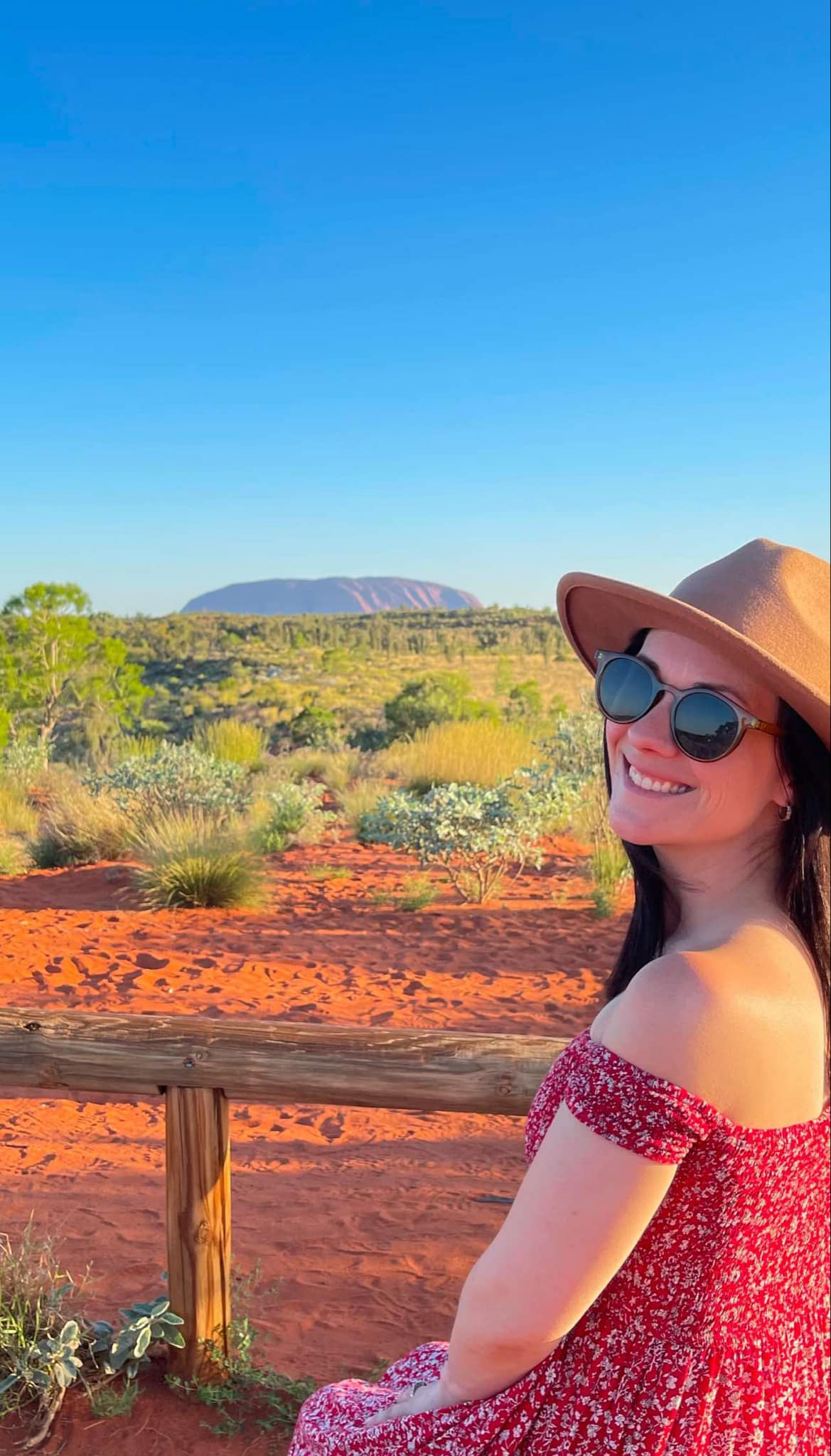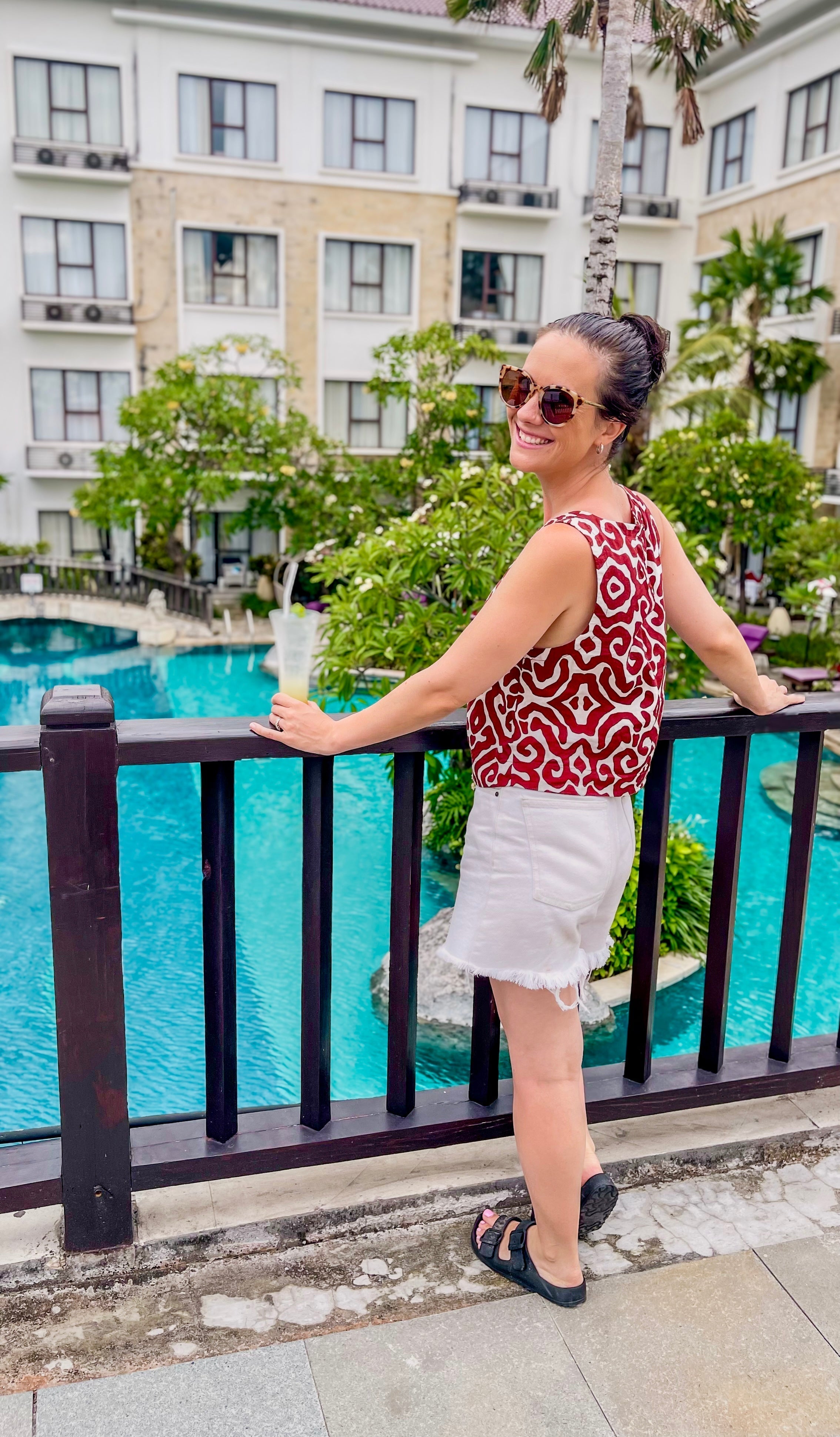Where to Stay in Bali with Kids? How to Choose the Perfect Area for Your Family Vacation.
Don't forget to pack a Bali Travel Diary & Activity Book if you're travelling to Bali with kids!
Each travel diary includes info about Bali, Bali-themed activities, video content (QR codes), space for photos, and journal pages.
KUTA:
Conveniently located near popular family-friendly attractions like Waterbom Park and Trans Studio and offering a variety of excellent resorts and shopping centres all designed with families in mind - Kuta is a great spot to have fun as a family.
However, my recommendation would be to avoid making Kuta your only destination. You’ll likely encounter haggling in this area, which can be tiresome, and if you only see Kuta, you won’t get a true feel for Bali's magic.
Pros: Convenient proximity to family-friendly attractions like Waterbom Park and Trans Studio - A range of family-oriented resorts and westernised shopping centres. You can also do a turtle release here, and there’s great surf if your kids want to do a surf lesson.
Cons: Occasional haggling encounters and limited appeal beyond touristy attractions. Due to the strong currents, beaches can also be full of trash in the wet season, so if you head to Kuta at this time of year, expect something other than pristine beaches.
Truntum Hotel is perfect for families wanting to stay in Kuta on a budget. You can read independent reviews here:
LEGIAN:
Nestled between bustling Kuta and trendy Seminyak, Legian provides many budget-friendly accommodation options and is a great middle-ground for families eager to explore Kuta's attractions without immersing themselves fully in its hustle and bustle.
It also offers easy access to the Instagram-worthy cafes and restaurants that Seminyak is famous for and plenty of places to get $10 massages.
Pros: Great place for your first visit: An attractive choice for families seeking affordability without compromising on experience. 3km walk in either direction into Kuta or Seminyak.
Cons: Can attract stereotypical ‘Aussies do Bali’ type crowd - think Bintang singlets, & beer cycle tours. Children with sensory challenges may find the traffic, noise and smell in Legian too much.
P.S. Many say the Padma is the only place to stay in Legian with kids, but in my experience, kids are just as happy with a pool, some pool toys, and an ice cream! You don't need to stay at the Padma to have an amazing family holiday in Bali.
SEMINYAK:
Renowned for its vibrant culinary scene with chic cafes and upscale restaurants, Seminyak is a foodie’s paradise and is very ‘Instagramable.’
Seminyak also boasts a beautiful beach and is known for its unforgettable sunsets, which provide the perfect setting for relaxation and cocktails.
Pros: Amazing food (and date night) choices that are half the price of Australia. Close enough to Kuta’s family-friendly attractions: more upmarket, beautiful boutique shops (with fixed prices) and gorgeous sunsets.
Cons: The beach in Seminyak is known for its wavy waters, which may not be ideal for small kids or children who aren't strong swimmers. You won’t get the 'budget Bali holiday' here, as prices are higher than other areas (although still cheaper than at home for the quality).
The Courtyard is one of my fav resorts for families in Seminyak. The standard and pool terrace rooms are both great! You can view independent reviews here:
Note: My recommendation if you want to book the Courtyard is you wait for a deal to come up on Luxury Escapes! I've found its the cheapest way to book!
Get $50 off your first Luxury Escapes booking by using the code: INVITEKIRSTINL1E9R1? at checkout!
I also rate Montigo as a family hotel in Seminyak! You can view independent reviews of Montigo here.Montigo Hotel: A great resort for families in Seminyak, Bali!
Don't forget to pack a Bali Travel Diary & Activity Book if you're travelling to Bali with kids!
Each travel diary includes info about Bali, Bali-themed activities, video content (QR codes), space for photos, and journal pages.
CANGGU:
While Canggu may have zero kid-orientated resorts, it offers plenty of villas and excellent family facilities like Finns, which has a fantastic water park for kids under 10, ten-pin bowling, and a trampoline centre.
Canggu also boasts a vibrant cafe culture with numerous vegan and gluten-free options and outstanding coffee.
Traffic and limited footpaths, however, can pose challenges for strolling with kids or using a pram, and its layout as a whole is less walkable than Kuta, Legian, or Seminyak, often requiring road walking, which isn't the safest option.
Pros: Great kid-friendly facilities and cafes with great coffee. Conducive to the villa life, which many families prefer.
Cons: Traffic congestion can be a challenge. Limited footpaths and not very pram friendly.
Photo taken at Bounce, Bali which is now closed. If you're looking for something similar check out AeroX in Sanur!
Get $50 off your first Luxury Escapes booking by using the code: INVITEKIRSTINL1E9R1? at checkout!
THE BUKIT PENINSULA: ULUWATU & JIMBARAN:
Uluwatu and Jimbaran grace visitors with breathtaking clifftop views and exude a romantic ambience better suited to couples.
Rather than basing your family here, I would visit these two areas on a day trip and tick off Garuda Wisnu Kencana (GWK) Cultural Park in the early afternoon, the Kecak Fire Dance and show at Uluwatu Temple at dusk, and then finish with dinner on Jimbaran Beach.
Pros: Excellent beach clubs and surfing. Cultural attractions, breathtaking views, and a quiet change of pace. Great seafood dining options.
Cons: Kids may get bored here if they aren’t easily entertained with a pool or playing in the sand. Better suited for couples – many people come here to get married or honeymoon.
Pictured above: GWK Cultural Park & views from Uluwatu Temple. You can book your own driver or book a private tour with Klook to see these sites.
UBUD:
Nestled in the jungle, Ubud offers a remarkable cultural experience for families with its rice terraces, temples, markets, and nearby waterfalls. Nonetheless, it is important to note that Ubud has evolved over the past few years and has shed some of its former tranquillity.
If you want to experience the culture but still have all the mod cons, Ubud is a great place to stay for a few nights; if you want to experience what Bali was like 20 years ago and see 'less staged' rice terraces, stay elsewhere.
Note: Lots of families love the monkey forest in Ubud. I find them overwhelming, and think it’s better to see monkeys at Uluwatu Temple, or on the way up to Candidasa or Sidemen. There’s also silver making in Sideman, a great and fun activity for older kids, as well as Baltik painting.
Pros: Cultural experience with the mod cons. Proximity to waterfalls, temples, and rice fields.
Cons: It has lost some of its serenity. Traffic can be bad, and while distance-wise it’s not far, it can take several hours to get back down to the airport, so allow plenty of time.

SANUR:
Despite its nickname "Snore," Sanur is far from a sleepy town; in fact, it is my favourite spot, and I feel one of the safest places in Bali for families.
The flat, beachfront pathway is perfect for strolling with prams, and the calm, sheltered bay of water allows for safe swimming.
Moreover, the abundance of restaurants ensures you are spoilt for choice, and as most are located on the main road or beachfront path, getting to and from dinner venues is very easy.
The other thing I love about Sanur is that as it is away from the super touristy hot spots on the other side of the island (Kuta, Legian, Seminyak, Canggu), it tends to offer more budget-friendly prices.
And it also serves as an ideal starting or ending point for your Bali adventure, given its proximity to the airport. It's also a great launchpad for island-hopping adventures, with all ferries departing from this town.
Pros: My top recommendation for families. Safe swimming area. Plenty of restaurants. The town is easy to navigate, with one main road up and down and the beach strip. Close proximity to the airport & islands. Can also do turtle releases here.
Cons: No MEGA resorts with the typical kid’s clubs like the other side of the island or Nusa Dua. Not a party place, minimal 'Instagramable' spots. Does attract a lot of retirees.
Our favourite place to stay in Sanur currently is Sagara Villas & Suites. We've stayed in both the rooms, and villas, and they're great value!

Sanur boardwalk at dusk
NUSA DUA:
If you are in search of a luxurious, all-inclusive resort experience, Nusa Dua is an excellent choice. Nusa Dua is home to a variety of kid-friendly hotels with exceptional kids' clubs and is the place to go if you want to try water sports like parasailing and jet skiing.
Plus, this area boasts pristine, well-maintained beaches and exudes a gated community ambience with lots of security, making it one of the safest places in Bali for families.
Pros: Manicured and stunning hotels with beautiful grounds. Lots of all-inclusive, which can be helpful for budgeting, as you know what you’re going to pay in total for your holiday before you go. Calm beaches. Nice restaurants and watersports. Ideal area for a plonk and drop/drink lots of cocktails by the pool type holiday.
Cons: Lacks culture, and the 'Bali vibe'. Sometimes it feels like you could be anywhere in the world. Not too much to do in the area besides eat and hang at resorts after a few hours of watersports. Can be pricey, and you may feel 'resort trapped'.
The Courtyard Marriot in Nusa Dua has an epic lazy river which kids love!
The Grand Mirage in Nusa Dua has an epic splash zone for kids. It also does an excellent all-inclusive package if that's what you're after and a lazy river is opening in 2025!
However, the best resort for kids in Nusa Dua if you want pure luxury is the Kempinski. The Kempinksi has giant pools, waterslides, 8 restaurants, and even an aquarium - what more could you want?!
Likewise, with the Courtyard, and Montigo, my recommendation if you want to book the Kempinski is that you wait for a deal to come up on Luxury Escapes!
Get $50 off your first Luxury Escapes booking by using the code: INVITEKIRSTINL1E9R1? at checkout!
THE SAFEST AREAS FOR FAMILIES:
Personally, I have never felt unsafe in any location in Bali, and neither has my family. The Balinese people, driven by a belief in good karma, go above and beyond to ensure tourists feel secure and welcomed, recognising the pivotal role tourism plays as their primary source of income.
Most crimes you hear about typically involve ex-pats and foreigners; however, if you are concerned about this, I recommend staying in Sanur or Nusa Dua, which are tourist areas known for their heightened sense of safety and tranquility.
A WORD ON TRAVEL INSURANCE:
I'm often asked which travel insurance, we use. If we haven't used the one associated with our credit card (or need extra cover), we use SCTI! I find SCTI the best travel insurance for families, those wanting to ride a scooter, or for those with pre-existing medical conditions.
BALI OFF THE BEATEN PATH: SIDEMEN, CANDIDASA, AMED:
If you are interested in venturing off the tourist trail and discovering the authentic side of Bali, places like Sidemen, Candidasa, and Amed offer a glimpse into what the island was like two decades ago, and in my opinion are all hidden gems, yet to be changed by mass tourism.
These areas allow you to immerse yourself in Balinese culture, explore stunning snorkeling, wander through lush rice fields, visit ancient temples, and admire breathtaking viewpoints.
However, it is important to note that if you have kids who are picky eaters, their dining options may be somewhat limited, with hot chips possibly becoming their go-to meal.
Western cuisine is less prevalent in these areas, and services like Grab and Go-Jek (the Bali version of Uber and Uber Eats) are non-existent. On the plus side, many restaurants in these regions are willing to provide pick-up and drop-off services at your hotel for added convenience.
You also will not find large resorts in these areas.
Pros: Authentic Bali. There’s waterfalls, temples, and cooking classes to entertain you, and beautiful snorkeling, water tubing, and ATV type activities within close proximity.
Cons: Quieter destinations, and you won't find the same range of restaurants, amenities, or activities as in the more touristy areas. Children may get bored here if they aren’t easily entertained by a pool, and aren’t yet old enough for snorkeling, water tubing, or ATV rides.
Other Notes: Many waterfalls are very steep, if your kids are younger than 6, I’d expect to carry/assist them - likewise, older travellers, and those with bad knees.
Cepik Villas is our favourite place to stay in Sidemen. We have stayed in both the standard rooms, and sunrise suite, and both are fantastic!
Sagara is one of our favourite places to stay in Candidasa
Candi Resort & Spa is also another top pick!
MUNDUK:
Nestled in Bali's highlands, Munduk is another area that offers families a tranquil and off-the-beaten-path escape amidst lush forests and serene rice terraces.
It's perfect for a short stay and is an ideal spot to unwind and enjoy nature, and would you believe it, even sit by the fire (Munduk offers much cooler temperatures).
With exciting ATV experiences and plenty of waterfall hikes close by, it feels like you are in the jungle when in Munduk.
Pros: Authentic Bali, remote, off the beaten path, away from the hustle and bustle. Cooler temperatures.
Cons: Won’t find kids clubs, or many western restaurants. Most activities here are suited to kids 6-7+ years of age.
The boys enjoying an ATV adventure at Munduk Wilderness Tours
In conclusion:
Bali is a VERY safe family holiday destination and the kind of place you will find yourself going back to again and again, so don’t feel like you need to try and see everything on your first visit.
Doing so could easily become overwhelming.
With kids, my advice (and experience) is to choose two areas to stay, or three if you are staying more than two weeks. No more.
Identify your priorities, whether it's proximity to a calm beach, high end restaurants, family-friendly hotels that specifically cater to kids, or cultural experiences, and shortlist from there.
Bali is relatively small (and although traffic is terrible in peak times), you can easily make day trips to most areas, if you or the kids have your heart set on something in particular, and it will ensure a much more enjoyable trip this way (instead of changing hotels every few nights).
And, of course, if you're heading to Bali with kids, remember to pack a Bali Travel Diary & Activity Book!
They're full of info about Bali (so kids know what to expect) tonnes of activities and learn the local language videos.
Plus, they’re great for keeping kids entertained on the plane, are a great alternative to screens when dining out, and are a great way to document your family vacation in Bali.
Kindest,
Kirstin
























